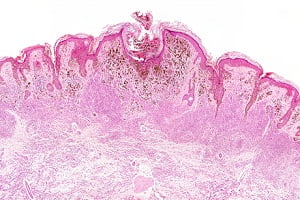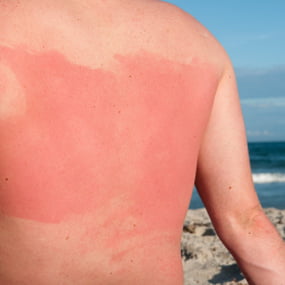What are the Different Types of Skin Cancer?
- Updated on: Nov 22, 2024
- 6 min Read
- Published on Apr 25, 2021

Skin cancer is a commonly occurring cancer of all types and affects people of all races and colors.
When you are trying to understand skin cancers, it is important to know how they work, as well as the differences between them. This means you have to focus on the best ways of being able to achieve this, and this means considering the differences between the different types, what symptoms they bring, and what the prognosis might be. You also have to try to make sure you think about the signs and differences between actinic keratosis vs squamous cell carcinoma. Being able to understand these better helps you know what you’re dealing with, and leaves you better prepared to be able to deal with the situation.
Types of Skin Cancer
Skin cancer is broadly classified into two main types:
Keratinocyte Skin Cancer (develops in skin cells called Keratinocytes):
The keratinocyte cancer subtypes are called as Non-melanoma skin cancers. These non-melanoma skin cancers occur due to prolonged exposure of body parts to sunlight. These occur mainly on parts exposed to sun such as neck, face, arms and head. These cancers are non-malignant i.e. they do not spread to other body parts through blood stream and are confined to one region of the body. The treatment for them is effective and they can be completely cured.
There are two subtypes of keratinocyte cancers:
- Squamous cell carcinoma: Squamous cell carcinoma accounts for 80% cases of the Keratinocyte cancer. Squamous cells are flat cells found in outer part of epidermis and constantly shedding off from body as new cells come. Squamous cell carcinoma is second largest commonly occurring skin cancer. It is uncontrolled and unusual growth of the squamous cells of the skin.
Squamous cell carcinomas are more likely to occur in people with fair skin tone and are common in immune-suppressed people. Squamous cell carcinoma is biologically similar to Basal cell carcinoma but differ in chances of spreading to different body parts.
Squamous cell carcinoma occurs due to prolonged exposure of a person to U.V rays of sun during his lifetime through many ways such as daily exposure, summer time intense exposure, and U.V rays produced from tanning beds that all add to the damage of skin cells and lead to skin cancer. This cancer develops in body parts exposed to sun such as head, neck, ears, back of hands, arms, bald scalp, lower lip, face but may also occur in other body parts such as chest, legs, mucous membrane and genitals (very rare).
The cells in this cancer often look like open sores, warts (crust or bleed), scaly red patches, and can develop in scars and chronic sores elsewhere in body. This cancer sometimes starts developing in actinic keratosis called as Keratoacanthomas. Keratoacanthomas are tumors found on skin exposed to sun that grow quickly and usually dome shaped in appearance. This tumors growth will slow down and stop and this can even shrink and go away completely from the body with time even without a treatment. Many skin care doctors consider it as a type of squamous cell carcinoma because in some cases this tumor continues to grow and spread to different body parts and even the growth is hard to predict.
About 1 million people in the U.S are diagnosed with squamous cell carcinoma each year i.e. about 2 out of 10 persons in the U.S have squamous skin carcinoma and the incidences increased to 200% in the past three decades.
Squamous cell carcinoma is also non-malignant type of skin cancer but if not diagnosed early and left untreated, the rate of invading surrounding tissues and organs increases and the cancer can also spread to other body parts as compared to basal cell carcinoma, causing disfiguring of the body and functional impairment in the body which may also lead to death.
It accounts for about 20% of all skin cancer types and according to different estimated data sources, it accounts for as many as 8,800 people’s death due in the U.S.
- Basal cell carcinoma: Basal cell carcinoma accounts for 20% cases of the Keratinocyte cancer. Basal cells line up the deepest layer of epidermis and are found in the lower epidermis part. They grow and divide to form new cells which replace the squamous cells that shred off from the skin surface of the body. As the basal cells reach the epidermis, they get flat and eventually become squamous cells.
Basal cell carcinoma is the unusual and uncontrolled growth of the basal cell forming lesions on the skin. Basal cell carcinoma occurs due to prolonged or occasional intense exposure of body parts or skin to the sun. It is more likely to happen in people with fair skin tone as they are more prone to sun burns but it also occurs in people with dark skin color. Several types of basal cell carcinoma are seen in people such as superficial type (least to worry about), modular type (most common type) and the morpheaform (most difficult to treat because tumor grows in surrounding tissues without a well defined boundary).
Basal cell carcinoma looks like red patches, scars, shiny bumps, pink growth and open sores on the skin. It commonly occurs on body parts exposed to the sun such as head, neck and arms but can also form in any other part of the body like abdomen, chest and legs.
Basal cell carcinoma are non-malignant and confined to one region of the body. Usually, it does not spread to other body parts like melanoma cancer does. But one should diagnose it early, as early intervention and treatment can cure the basal carcinoma easily. If not diagnosed and left unnoticed, it invades the surrounding tissues and organs causing deformities and loss of function of some body parts and even pose a threat to life.
It is the most common cancer of skin affecting more than 4 million people in the U.S each year. It is most frequently occurring cancer of all cancer types and more than 1 out of 3 newly diagnosed cancer cases in skin cancers are basal cell carcinoma majorly.
An early diagnosis of skin cancer helps in identifying the types of skin cancer and to decide proper treatment options and identify its prognosis. Squamous and Basal cell carcinomas are considered non-malignant as they do not spread in other parts of the body and invade the tissue. Their treatment is effective and curable.
Melanoma Skin cancer:
It occurs in skin melanocytes that generate brown pigment of the skin. Melanocytes are the brown pigment making cells of the skin. Melanocytes form benign growth of moles also. Melanocytes form brown color pigment of the skin when the skin is exposed to sun to protect the skin from damage from harmful radiations. Moles or tumors appear brown or black in color. But sometimes melanocytes do not make pigment so the tumor appears pink or white in color. Melanoma is a less common type of skin cancer as compared to basal and squamous cell carcinomas.
Melanoma is also called as malignant melanoma and it is one of the deadliest types of skin cancers. It is malignant in nature, and therefore, if left untreated and unnoticed it may spread to other body parts through the blood stream, invade the surrounding tissues and organs, and also grow rapidly.
Melanoma usually occurs due to prolonged exposure of the skin to harmful U.V. rays of the sun during the lifespan of a person. The DNA of skin cells get damaged and unrepaired due to mutations or genetic defects by harmful U.V. rays of the sun.
Melanoma skin cancer can develop anywhere in the body where our skin is exposed to the sun but it is more likely to occur on legs in women and chest and back in men. It commonly occurs on face, hands and arms also that are exposed to sunrays. This type of cancer can also form in other body parts such as mouth, genitals and eyes but this is rare.
People with lighter skin tone are at higher risk of developing melanoma due to lesser brown pigments to protect the skin cells. It is seen that people with a darker skin tone are at lower risk of getting melanoma, although, melanoma can happen to anybody regardless of color, race and ethnicity.
Melanoma on palm, heads, under nails, and soles of feet are more common to Afro-American population than whites.
An early diagnosis of melanoma is necessary to control its spreading to different body parts and to avoid it to become a cause of death for someone and also to help cure it completely. It is estimated that an early diagnosis and treatment of malignant melanoma helps in saving lives of people from death.
Although the percentage of occurrence of melanoma is only 2% of all skin cancers, but it the most common cause of death in people from skin cancers. It is estimated that annually 10,130 people are killed in the U.S due to this malignant carcinoma and the number of cases of melanoma is increasing every year in U.S.
According to an estimate done in 2016, about 76,380 cases of invasive melanoma are diagnosed in which approximately 46,870 are males and 29,510 are females.
The early signs of melanoma can be noticed and detected by ABCDEs which stands for-Asymmetry, Border, Colour, Diameter and Evolving.
There are several other skin cancers such as Marker cell carcinoma, Skin lymphoma and Kaposi sarcoma but they are rare.













1 Comment
Your point of view caught my eye and was very interesting. Thanks. I have a question for you.